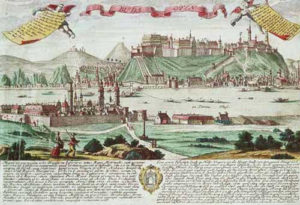Pest

Pest is the eastern part of Budapest, Hungary, comprising about two-thirds of the city’s territory. It is separated from Buda and Óbuda, the western parts of Budapest, by the Danube River. Unlike Buda, it is not a hilly, but rather plain area. Among its most notable parts are the Inner City, including the Hungarian Parliament, Heroes Square, and Andrássy Avenue. In colloquial Hungarian, “Pest” is often used for the whole capital of Budapest. The three parts of Budapest (Pest, Buda, Óbuda) united in 1873.

In earlier centuries there were ancient Celtic and Roman settlements there. Pest had been a separate independent city, references to which appear in writings dating back to 1148. It became an important economic center during the 11th–13th centuries. The first walls around the city must have been completed in the first part of the 13th century.

The first privilege was granted to Pest by King Endre II in 1230. King Béla IV set out with his army against the invading Mongols in 1241 from Pest. However, after the Battle of Muhi, it was burned down by the Mongols. It was the crossing place where the Mongols could cross the Danube River when it froze over in the winter of 1241/42. When they left Hungary, Pest was rebuilt once again. King Béla had a castle built there between 1247 and 1265 but it was not too formidable and could not protect the inhabitants properly.
The documents from the first part of the 15th century mention Pest as a “city without walls”. Pest was a privileged “free royal town” in 1470. The new stone walls of the city were built between 1443 and 1479 during the reign of King Matthias Corvinus. This time, the city has been enlarged from 23 to 55 acres. The length of the wall was 2.2 km at that time.

Demographically, in the 15th century, Pest was mostly Hungarian, while Buda across the Danube had a German-majority population. There were four gates in 1490, gates called Hatvani, Kecskeméti, Váci, and Belgrádi. There were many bastions between the gates, too. You can read more about the history of Buda Castle here:
https://www.hungarianottomanwars.com/ottoman-occupied-lands/buda/
Fights were going on in Pest in 1526 when the Ottomans took and plundered Buda for the first time. The inhabitants fled from the Turks, though. When the enemy left, they returned and repaired the walls. Oláh Miklós mentions the walls of Pest in his historical work in 1536.

The next siege of Pest took place in 1540 when King Habsburg Ferdinand sent his army to take Buda away from the heir of the late King Szapolyai but they could only take Pest. It was Prior Martinuzzi (aka Fráter György, the White Monk) who made an attempt to retake Pest in the spring of 1541 but the siege was lifted when General Roggendorf’s army arrived. Partly due to the Habsburgs’ interference, the Ottoman Turks managed to take both Buda and Pest later in the summer of 1541.

German troops arrived in the summer of 1542 to retake Buda. The besiegers deployed their troops around Pest and tried to take it from the Turks. King Ferdinand sent Joachim of Brandenburg with his small and badly equipped army to retake Buda. Sultan Suleiman sent his reinforcement against them (in his army, there was Lord Perényi Péter`s son, Ferenc, a 20-year-old lad by this time, as a hostage).

Suleiman knew that the leader of the Hungarian army was one of the wealthiest Hungarian barons, Perényi with 15,000 men. They could temporarily take Pest but the campaign has ended in disaster. Ferdinand thought of betrayal and had Perényi arrested in October. Here is more about Lord Perényi’s most interesting life that explains much about the period of the bloody Dual Kingship of Hungary:
https://www.hungarianottomanwars.com/essays/lord-perenyi-peter-1502-1548-part-one/
After 1542, the Ottomans repaired the ruined walls and enlarged them with a wooden palisade. When the Imperial troops managed to take Pest between 1602 and 1604 during the 15-Year War, the Ottomans often bombarded Pest from Buda castle.
The siege of Pest on 5 October 1602


https://www.hungarianottomanwars.com/chronologie/the-fifteen-year-war-series-1591-1606/

After the unsuccessful Ottoman siege of Vienna, the Imperial troops wanted to seize Buda as well. However, they could not take it in 1684. Then, the Turks emptied the town of Pest and set it on fire. When the Christians returned in 1686, they did the same. As a result of this, the walls were in a very bad condition when Pest was taken back in 1686. The last time when the walls were fully repaired happened during the War of Independence of Prince Rákóczi Ferenc between 1703 and 1711.

The walls began to disappear after 1780 when lots of sections were demolished. The last gate, the Hatvan Gate was pulled down in 1808. However, one can still discover a significant length of the walls on the yards of Pest’s houses. You can see many remains of the 2-kilometer-long old wall in the pictures below.

(Source: partly from Szibler Gábor)
Dear Readers, I can only make this content available through small donations or by selling my books or T-shirts:
Please, support me with a coffee here:
You can check out my books on Amazon or Draft2Digital, they are available in hardcover, paperback, or ebook:
https://www.amazon.com/dp/198020490X or at https://books2read.com/b/boYd81

My work can also be followed and supported on Patreon: Become a Patron!http://Become a Patron!
[wpedon id=”9140″]

https://hungarianottomanwars.myspreadshop.com/all

Here are some of the remains of the city wall of Pest:






















